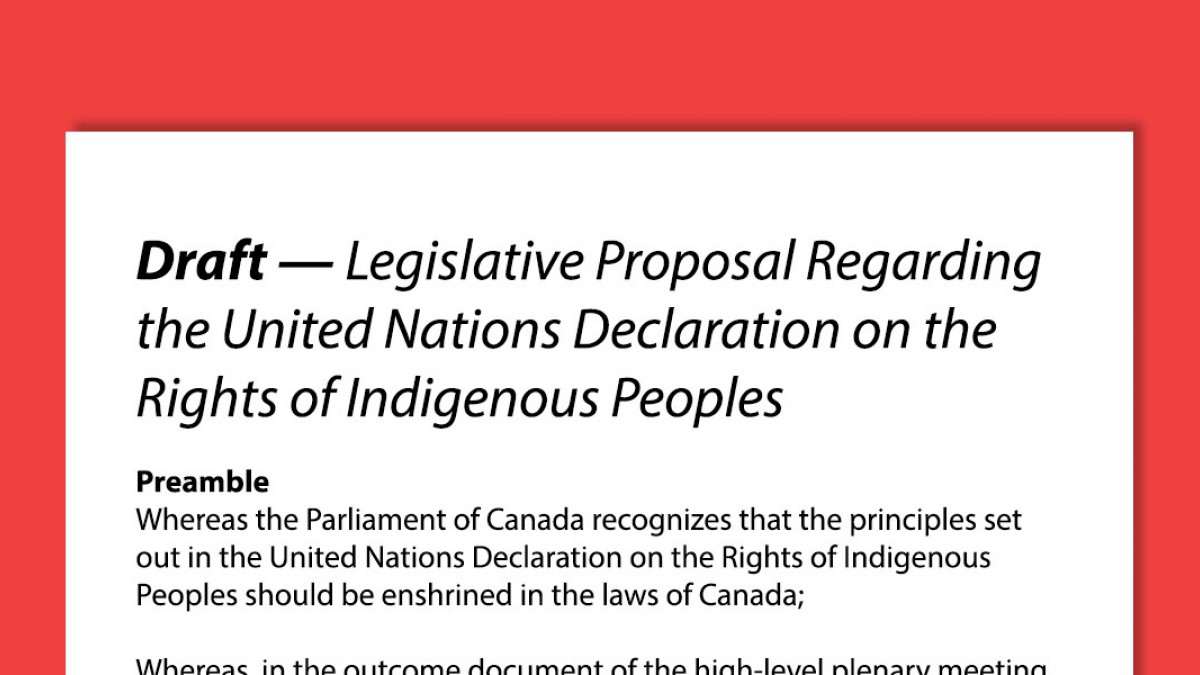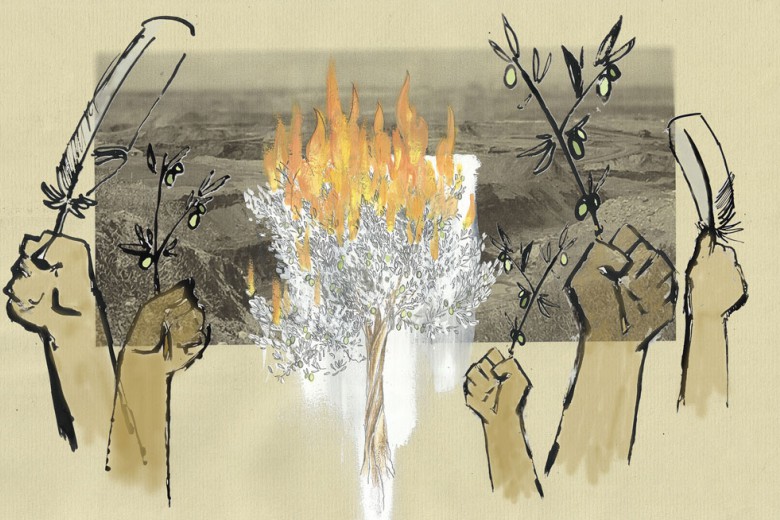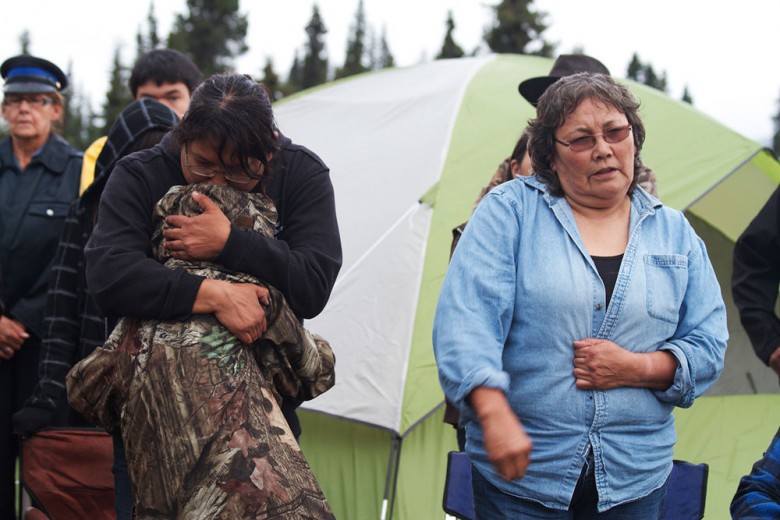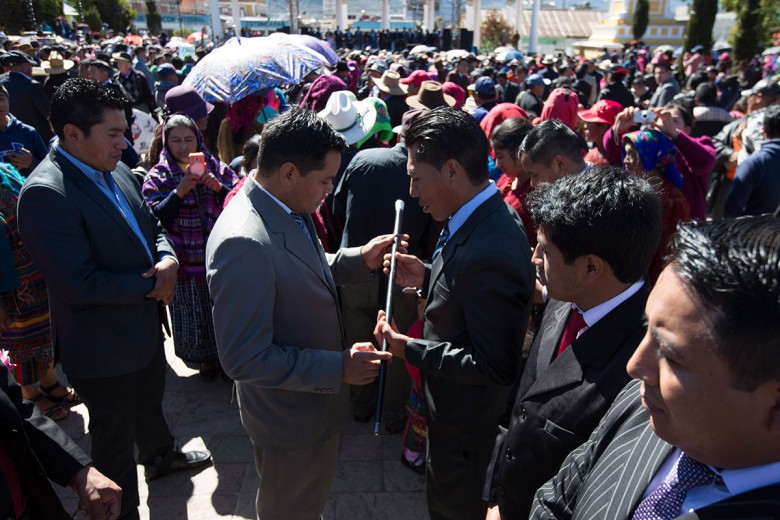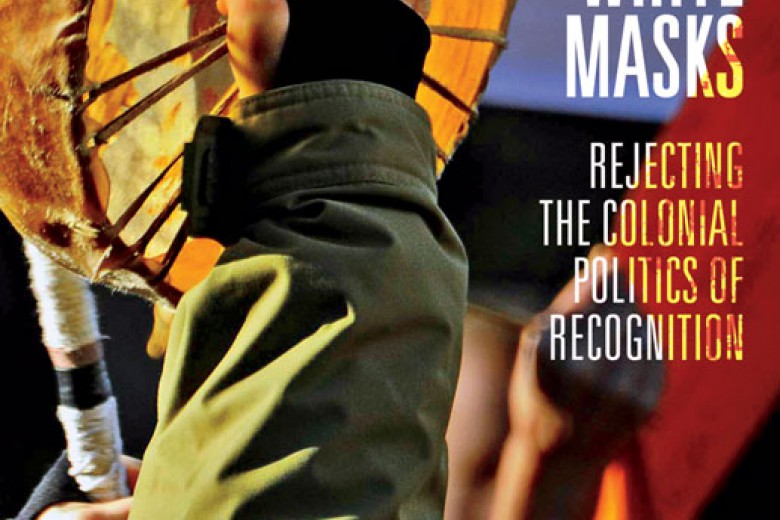Briarpatch has obtained a draft of federal legislation to turn the United Nations Declaration on the Rights of Indigenous Peoples (UNDRIP) into law. The draft was leaked by someone close to the drafting and consultation process. It was first published online by the Media Co-op yesterday, October 8, as an addition to “Briefing Note on Canada’s Use of UNDRIP as Cover for implementing White Paper 2.0 National Termination Plan” by Russ Diabo, a long-time First Nations policy analyst and recent candidate for National Chief of the Assembly of First Nations (AFN) in 2018.
Similar legislation to align federal laws with UNDRIP was proposed back in 2016 by opposition NDP member Romeo Saganash and nearly became law as Bill C-262, but delays in the Senate meant it did not pass before the 2019 election and so was wiped from the slate. The current Liberal government has promised to table (meaning introduce to the House of Commons) UNDRIP legislation by the end of 2020.
Asked for comment on the UNDRIP legislation drafting and process, Ian McLeod, a spokesperson for the Department of Justice, tells Briarpatch, "The Government of Canada remains committed to introducing legislation on the United Nations Declaration on the Rights of Indigenous Peoples before the end of 2020. Building on the support for former Private Member’s Bill C-262, and following discussions with Indigenous partners, we are using this bill as the basis of a new draft legislative proposal.”
While this may be seen as a move towards respecting Indigenous rights, several close watchers of settler government policies and practices are raising significant concerns about this legislation and its implementation.
Here we include the draft legislation in full (the first two pages contain the legislation, the next seven are a copy of the UN Declaration).
What’s in and what’s missing
“Romeo’s bill had a lot more spirit, because it had a lengthy and powerful preamble, and the federal government of course cut all of that and watered it down,” says Dr. Hayden King of the leaked draft legislation. King is the executive director of the Yellowhead Institute, an Indigenous policy think tank based out of Ryerson University. “But in terms of the operative pieces of the legislation, it’s basically word for word to that private member’s bill.”
The draft stipulates that the government of Canada must “develop and implement a national action plan to achieve the objectives of [UNDRIP].” It also mandates that for the next 20 years, the Minister of Crown-Indigenous Relations must report each year on any progress made on the action plan and on aligning Canada’s laws with UNDRIP.
Given that Saganash’s proposed UNDRIP legislation is now over four years old, King expresses “surprise, actually, that the federal government didn’t incorporate elements of stronger pieces legislation, in particular B.C.’s UNDRIP implementation.” In November 2019, British Columbia became the first province to pass legislation mandating the government to ensure its laws are consistent with the Declaration.
“Romeo’s bill had a lot more spirit, because it had a lengthy and powerful preamble, and the federal government of course cut all of that and watered it down.”
King explains that in the leaked draft legislation, “the feds have to consult with Native peoples to develop the action plan, but when it comes to reporting on the progress of implementation they do not have to consult. So they can put whatever they want in that report and there’s virtually no mechanism to hold them accountable for lack of progress.”
“The British Columbia government at the least has held itself accountable to Indigenous leaders by saying, ‘We’re going to co-develop this national action plan with you but we’re also going to co-develop the outcomes document, the reporting on the progress document.’ So it’ll be at that stage in the process where that’s the accountability mechanism,” says King. “But that doesn’t exist in the federal legislation, and I think that’s telling of the federal government’s unwillingness to incorporate these sort of new policy innovations. I think they prefer to have that interpretive runway.”
While the draft legislation has a section titled “Consistency,” stating, “The Government of Canada, in consultation and cooperation with the Indigenous peoples of Canada, must take all measures necessary to ensure that the laws of Canada are consistent with the United Nations Declaration on the Rights of Indigenous Peoples,” King points out that it’s very vague. “How are they going to do that?” he asks, noting that there is no clear mechanism of “consultation and cooperation.”
“Whereas the B.C. legislation is specific about this, there is actually statutory power that Indigenous people in that province can take on, there is nothing like that in federal legislation. I don’t know what [this clause] means. There’s nothing specific about it,” he adds. “The feds … they’ll talk about co-development all day long, but co-development is still – you ask any insider who’s been part of those processes – it’s a ‘take it or leave it’ approach.”
"So they can put whatever they want in that report and there’s virtually no mechanism to hold them accountable for lack of progress.”
In addition, says King, “Once this bill gets passed in parliament, if it does, it’s not retroactive, meaning it doesn’t apply to previous legislation. So nothing fundamentally changes about the relationship. Nothing at all. Now, when new legislation gets introduced, cabinet has the responsibility to ensure it aligns with the [UN] Declaration on the Rights of Indigenous People. But really, so what? What about the hundreds of pieces of legislation that infringe on the rights of Indigenous Peoples already?”
Russ Diabo, who first published the draft legislation with the Media Co-op, writes in his briefing note that the “National action plan” section of the draft UNDRIP legislation “gives Canada a dominant role in interpreting UNDRIP ‘principles’ in relation to federal laws, since under Canada’s constitutional division of federal and provincial powers, the provincial governments have a veto in subject areas that may affect their jurisdiction.”
In these ways, the legislation contains numerous impediments to quickly and fully implementing the rights that UNDRIP is meant to uphold.
Settler UNDRIP legislation as delay, distract, and control tactic
When the Trudeau Liberals were first elected with a majority in 2015, they “had this very sweeping agenda for transforming relationships with Indigenous people,” King remembers. “We had the Department of Justice’s 10 Principles [respecting the Government of Canada’s relationship with Indigenous peoples], we had the splitting of Indian Affairs [into two ministries], we had all these changes to the machinery of government, and then the culmination of this, and really the centrepiece … was supposed to be this Rights Recognition and Implementation Framework legislation. First Nation youth and eventually leadership pushed back against that legislation, and that legislation fell.” The government’s process for drafting the framework was seen by many First Nations to have been top-down, and not reflective of the input they gave during consultations.
In a statement to Briarpatch, the Office of the Minister of Crown-Indigenous Relations writes that, “Since 2015, we have been working with communities to advance interest-based discussions and ensure that co-development is at the core of any negotiations or discussions with Indigenous groups through the Recognition of Indigenous Rights and Self-Determination discussion tables. At the heart of these discussions is supporting communities so that they can exercise their rights – whether it’s regarding education, child welfare, title, self-government or other community priorities. This work is currently taking place at 150 negotiation tables across the country with partners representing over 890,000 Indigenous people across the country.”
They “had this very sweeping agenda for transforming relationships with Indigenous people," King remembers.
“I think the federal government still wants to move forward with this transformative narrative but they realize they can’t do it through self-governing legislation like Rights Framework because of the resistance,” King says. “But they know that the [UN] Declaration is widely supported – almost universally supported – by Indigenous Peoples, so that I think is the consolation for the federal government.”
“I think while there was an initial hesitance to sign on to Romeo Saganash’s private member’s bill and then develop their own legislation, I think they have looked at the landscape in British Columbia in particular and seen that UNDRIP legislation is actually no big threat to the federal government or the concepts like parliamentary supremacy or provincial and territorial rights, because any action on implementing the Declaration can just be delayed,” he adds.
“Sure, there’s a 20-year commitment to implementing the Declaration and reporting on it and a national action plan on an annual basis, but there’s no real concrete steps to breathe life into things like free, prior, and informed consent or self-determining. So I think this Declaration legislation is very similar to other pieces of legislation or changes the Liberal government has made over the course of five years, which is heavy on symbolism, and really just a retrenchment, a reinforcement of existing policy.” King lists some of these existing policies the Liberal government has been intent on maintaining, such as: “keeping the band council system intact, limiting [First Nations’] jurisdiction to reserves, and no concrete movement towards any redistribution of wealth or resources. So the short story is it fits perfectly in the Liberals’ reconciliation plans as being a hollow gesture.”
"I think they have looked at the landscape in British Columbia in particular and seen that UNDRIP legislation is actually no big threat to the federal government or the concepts like parliamentary supremacy or provincial and territorial rights, because any action on implementing the Declaration can just be delayed.”
King notes that, because this legislation doesn’t mandate any specific actions beyond a report, that it is “creating this separate channel, [is] creating this Declaration on the Rights of Indigenous People channel, that actually delays the application of UNDRIP. The whole process delays application of UNDRIP. I think that’s by design.”
In his briefing note, Diabo points to additional troubling context, placing the UNDRIP legislation as part of the Liberal’s strategy to convince First Nations to agree to modern treaties which place them firmly “within the Canadian constitutional framework” and as the “fourth level” of government in Canada. This means that First Nations are put within the jurisdiction of the federal government (first level), within provincial jurisdiction (second level), and also within municipal jurisdiction (third level). First Nations, in this framework, are not on a nation-to-nation grounding with Canada, and instead find themselves in weaker legal standing than individual municipalities. All the laws of the federal, provincial, and municipal governments apply to them in this situation, giving very little room for self-determination.
The disappointment of the British Columbia UNDRIP legislation
What can be learned from the passing of UNDRIP legislation in British Columbia last year? Briarpatch asked Dr. Judith Sayers, president of the Nuu-chah-nulth Tribal Council (on Vancouver Island, B.C.) to share her perspective.
“The legislation in B.C. was drafted with B.C. and the [First Nations] Leadership Council, which is the leaders of the three organizations (the B.C. Assembly of First Nations, the First Nations Summit, and the Union of B.C. Indian Chiefs) and their technical people,” Sayers explains. “It never came to the communities ever, until days before it was tabled.”
“There’s only really two mechanisms in there. One is to change [existing] laws to be consistent with UNDRIP. And the other one was to do shared decision-making models or consent before decisions.” B.C.’s legislation doesn’t make it possible for Indigenous groups to sue the government for failing to honour UNDRIP. In the year since the legislation passed, says Sayers, “nothing has been done. In this last legislative assembly session they tried to pass three laws – three – without even coming to talk to us, and that had major implications for First Nations: clean energy, mental health, mines. They didn’t do anything to address UNDRIP. And why are they changing legislation without that?”
“It never came to the communities ever, until days before it was tabled.”
The big problem, in Sayers’ view, “is implementation and political will. Is it just the bureaucrats that are holding this up or is it that the direction isn’t there?”
Sayers describes an example. “One of groups that I work on, Heritage Conservation, we wanted to do a joint decision-making model for protecting our sacred sites and that, and the Assistant Deputy Minister told us, ‘No, I don’t have any mandate whatsoever to look at models like that or to change the law according to UNDRIP.’ And that’s what our job is; to change the legislation! So they want us to continue working to change the law without even looking at UNDRIP.”
Asked whether there was anything positive about B.C.’s UNDRIP legislation, Sayers replies with a blunt, “I can’t think of anything. Honestly, like seriously – they did this annual report and they said they talked to all the modern treaty nations, so I figured there were still 192 First Nations they needed to work with,” Sayers says with an exasperated laugh. Only eight First Nations have signed modern treaties in B.C.
For Hayden King of the Yellowhead Institute, “the big thing we learned from B.C.’s UNDRIP legislation is how glacial the progress is. I think this was really highlighted when you had Coastal GasLink basically escorted by the RCMP onto Wet’suwet’en territory to build this pipeline just after B.C. UNDRIP legislation was passed. And Indigenous people are saying, ‘What’s going on, are you passing UNDRIP into law or are you not passing UNDRIP into law?’ And then the B.C. government had to do all these gymnastics over the course of six months to try to explain to First Nations in the province that yes, we want to move forward with implementation but it’s a gradual process, we have to go back and look at all the old legislation and review it and update it and introduce it and debate it and send it to committee, and [for] any new legislation we need to create this working group and sit down and talk about it and discuss it. So it’s just process. Process on process on process. In theory the B.C. legislation is way better than the federal government’s [draft] legislation, but it’s still limited by how long it takes to see any tangible results.”
"And that’s what our job is; to change the legislation! So they want us to continue working to change the law without even looking at UNDRIP.”
Sayers says that, to be in accordance with the UNDRIP legislation, the B.C. government should be treating First Nations in the province as equal governments with which to share decision-making powers – but they’re not. “On this whole COVID thing, we’ve been fighting [the B.C. government] tooth and nail to get proper equipment and rapid testing machines and money for screening, training, etcetera,” she says. “You know, we work with the federal government but the B.C. government won’t share with us where there are COVID cases in nearby communities. And we say we need that.”
“So we had to bring in a complaint to the privacy commissioner [about the location of COVID cases]. It helps us make decisions – do we up our security, do we lock down, do we not? Just things like that that we as governments need to make decisions, but we can’t do that because we don’t have the information,” she continues.
Putting UNDRIP to work
Asked what could have made the UNDRIP legislation stronger, Sayers points out the need for action, rather than perpetual delays.
“Changing legislation is a long-term process. It takes a long time for them to go through their process and consult with everybody they need to consult with. So we need some interim measures,” she explains. “What can we do now, some timelines, joint decision-making, let’s put these in place within six months of the start of the process, in a timely fashion. Something that brings the government to the table.”
"We need some kind of body that has teeth so we can get through these things and implement them.”
Another crucial element, Sayers says, is “that we have an independent body of some sort to oversee that these things get implemented. The Declaration has words like ‘restitution’ and ‘self-determination’ and ‘free, prior and informed consent,’ and you know we’re never going to reach the same definitions [with the B.C. government]. If we had someone who could intervene between the two parties and work something out, then that would make it workable. But we don’t have that kind of a body in place to do that. So you’ve heard, of course, [Justin] Trudeau and [John] Horgan and Scott Fraser say, ‘Free, prior and informed consent is not a veto.’ But what is consent? It’s yes or no. Those sorts of big issues are still out there. So we need some kind of body that has teeth so we can get through these things and implement them.”
“I think there was potential in the legislation,” she says. “I would have put a lot more stuff in there to give us more mechanisms to work with, but I didn’t have that opportunity until a week before the legislation was tabled and we had to sign non-disclosure agreements and weren’t allowed to talk about it.”
The consultation process for this legislation
“Engagement and consultations with Indigenous organizations and partners have begun,” says Ian McLeod, a spokesperson for the Department of Justice, in comment provided to Briarpatch. “We are currently engaging with Indigenous partners, including the Assembly of First Nations, Inuit Tapiriit Kanatami, and the Métis National Council. We are also engaging with modern treaty partners, rights holders, and other Indigenous organizations and groups. Discussions with provinces and territories and industry partners are also taking place or will be taking place in the next few weeks."
Sayers notes that the Nuu-chah-nulth haven’t seen the federal draft legislation yet. “[The federal government hasn’t] tried to talk to First Nations across the country, although I’ve heard [Minister of Justice David] Lametti’s out there, but he hasn’t contacted the Nuu-chah-nulth peoples.”
On an Assembly of First Nations virtual meeting on October 7, Sayers questioned National Chief Perry Bellegard about the legislation and the consultation process. “He says, ‘Well, you know, I have a motion that says that I can do this [consult on behalf of First Nations] using the last law as the floor [Saganash’s failed bill], and then I have this technical working group in place,’ and he named them, and half of them aren’t Indigenous,” Sayers tells Briarpatch. “Where are they getting their direction from?”
If this continues to be how consultation and cooperation happen, it is hard to see how it would represent a nation-to-nation relationship.
“I asked him, ‘Why are we not able to be part of this?’ That’s what they’re supposed to be doing, that’s their job, to talk to 633 First Nations about the law,” she adds. “They just want to rush this through and then you get a law that’s put in place that has no enforcement mechanisms.”
Diabo, in his briefing note, writes that “the reference to ‘consultation and cooperation with the Indigenous peoples of Canada’ has meant for the past four years that the Trudeau government uses the three National Indigenous Organizations and three National Leaders, through what is called ‘Bilateral Mechanisms’, which means three federal-Indigenous Cabinet Sub-Committees, where the federal government controls the funding, pen and agenda.” If this continues to be how consultation and cooperation happen, it is hard to see how it would represent a nation-to-nation relationship.
“Canada will continue to advance community-driven discussions and ensure mutual respect and partnership are at the core of any negotiations or discussions with Indigenous groups going forward,” the Office of the Minister of Crown-Indigenous Relations tells Briarpatch in a statement. “Implementing the United Declaration on the Rights of Indigenous Peoples through legislation sets the roadmap forward to continue the work of advancing reconciliation.”
“What frustrates me the most,” Sayers tells Briarpatch, “is they make all these political promises and they build up our hopes – ‘Hey, a new relationship, we can do this!’ – but then the implementation just doesn’t happen. Good words, no action.”


